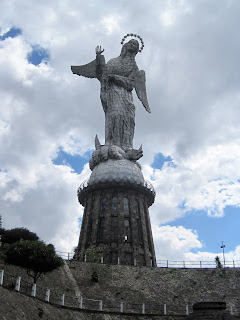Thought I should finish Colombia before I start on Ecuador.
From Medellin we headed south to Jardin, a small town in the Andes, known for its brightly painted houses and colourful floral displays. We had a relaxing afternoon sitting in the town square, walking around the town until it started to rain so we found a coffee shop to watch the downpour from. The main plaza has lovely rose gardens and behind it is the neo-gothic Basilica of the Immaculate Conception.


The next day we headed to Manizales, a further 5 hours drive south and centre of the coffee growing area of western Colombia. At an elevation of over 2,100m/7,000ft the city has very steep streets and is spread out over a wide area connected by 4 aerial tramways or cable cars. In 1914, construction began on the Manizales - Mariquita Cableway, a 72km ropeway to enable transport of coffee from the region to the ports. The only roads at that time were dirt and building of a railroad was thought to be impossible given the mountainous terrain. The cableway operated for nearly 45 years until it became too expensive to compete with road transportation and ceased in 1967. Tower number 20 is the only one that still exists and was declared a national monument as it was made entirely out of wood. All steel, tools, supplies and machinery for the towers were shipped from England however a German submarine sunk the ship in 1916 that was carrying number 20, so the local engineers followed the plans and made it from wood.

The view from today's cable cars
We walked up to one of the highest points in the city, Chipre Tower
We had a day trip to a sustainable speciality coffee farm, Tio Conejo. Their hospitality was great and the coffee wasn't bad either :-)
Next stop, Salento and the Cocora Valley, home of the wax palm and Colombia's national tree. We had a great afternoon hiking through the valley, even though it took me longer than normal thanks to the altitude (2,400m)
Another 200km south we reached the city of Cali. We stopped in at the local zoo to see animals we had not been able to in their natural environment, such as the jaguar and giant ant eater
I know tigers aren't from Colombia, but I couldn't resist these two kitties
The city has a cat park - Parque El Gato, full of cat sculptures. It started as a municipal project to beautify the banks of the river and now has 15 smaller cats painted by different artists.
Here are a few of the buildings
and some pics from the gold museum
Further south along the Pan American highway corridor we got to Popayan, also known as the white city due to the colour of most of the colonial buildings in the historic centre and after the more recent conflict, the city of peace.
The city is the home of an ancient pre-Hispanic pyramid known as El Morro del Tulcan, which was already abandoned when the first Spanish arrived. We walked up to the lookout at the top of the pyramid to view the city below
As we were still a way from the border with Ecuador, we drove another 250kms south (and five and a half hours) until we reached the city of Pasto. At an elevation of 2,800m we had a slow walk around the town before it got dark and saw some lovely old churches
The UK government had issued warnings about southern Colombia and the border regions with Ecuador, advising to stay on the main highway and not venture off in either direction due to trouble with rebel groups (FARC). All the way down the Pan American Highway from Cali, there were military personnel giving us the thumbs up as we drove by, a sign that the road was clear ahead. The scenery was stunning and it was easy to see how rebels could hide out in the mountainous terrain.
We crossed the border into Ecuador and are now in Quito, the highest capital in the world (2,850m). La Paz in Bolivia is higher and even though it is the seat of the executive and legislative branches of the government, Sucre is the constitutional capital. We learn something new every day :-)




























































